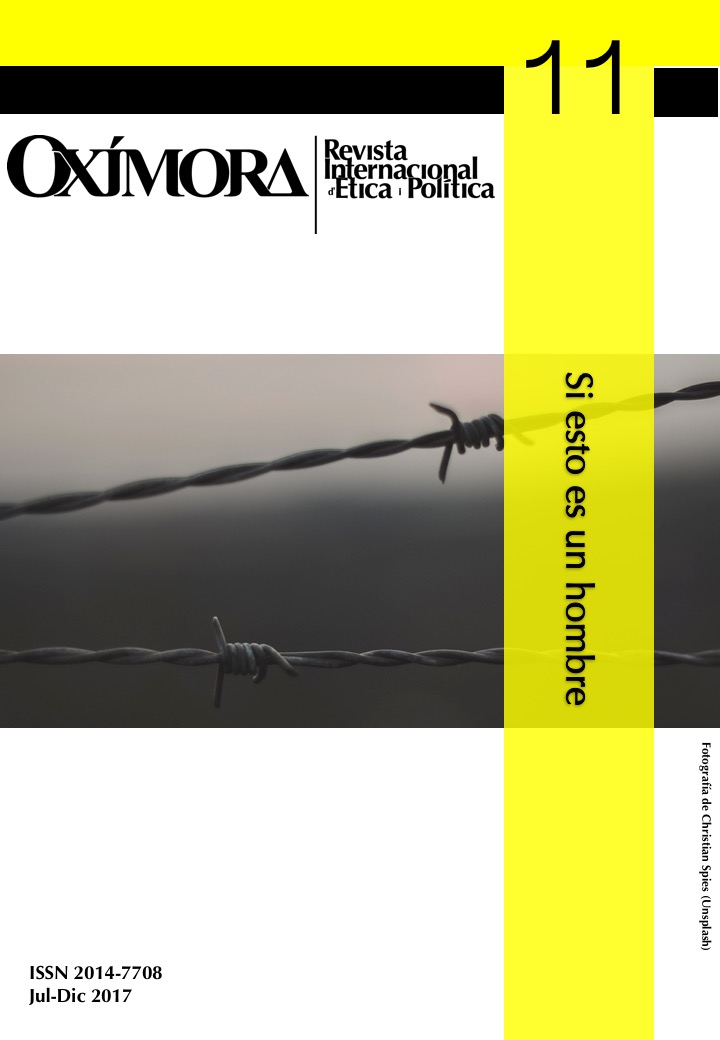Despoilment, Deportation and Confinement: The Fate of German Residents in Latin America During the Second World War
DOI:
https://doi.org/10.1344/oxi.2017.i11.19940Keywords:
Latin America, United States, Second World War, Germans, Japanese, Italians, Concentration Camps, Deportations, Good Neighbour Policy, Axis CountriesAbstract
This article sheds light on the adventures of the Germans and citizens from other Axis countries resident in Latin America during the Second World War. Considered a threat to hemispheric security, and given the political, economic and diplomatic pressure exercised by the United States in the region, the Italians, Japanese, and especially the Germans were subject to expulsion, reclusion, and expropriation. This interference, aimed at aligning all the governments in a common struggle against the foreign enemy shed light on the fact that the Good Neighbour Policy, established by the northern power after the Great Depression to repair its relations with Latin America, in truth, was used during the war to exaggerate what a danger they were and, as such, combat –in an apparent framework of legality, and in law- competitors that hindered the expansion of North American capital. The article outlines the way in which deportations, Proclaimed Lists or blacklists, confinement in concentration camps, expropriations and the nationalization of the property of citizens for the Axis countries, especially Germans, were used to make it easier for people from the US to enter Latin America together with their industries and businesses. This occurred in the context of industrialisation that a number of countries were developing and in which the US was also interested as a way to expand its economic imperialism.
References
BIERMANN, Enrique. (2001). Distantes y distintos. Bogotá: Universidad Nacional de Colombia.
BRADEN, Spruille. (1971). Diplomats and Demagogues. New Rochelle, N.Y.: Arlington House.
BULMER-THOMAS, Victor. (1989). La economía política de América Central desde 1920. Tegucigalpa: Banco Centroamericano de Integración Económica.
BUSHNELL, David (1984). Eduardo Santos y la política del buen vecino, 1938-1942. Bogotá: El Áncora Editores.
CALVO, Carlos. (1985). Costa Rica en la segunda guerra mundial, I939-I945. San José: Editorial Universidad Estatal a Distancia, 1985.
CLIFFORD, Sharon (1974). The Germans in Guatemala during World War II. Master's thesis, Florida Atlantic University.
CRUZ, Arturo. (2010). Crónicas de un disidente. Bogotá: Lea Grupo Editorial.
DÍAZ, Ismael (2015). Japoneses en América. Exclusión e internamiento en campos de concentración. Barcelona: Trabajo final de grado. Facultad de Traducción y de Interpretación, Grado de Estudios de Asia Oriental, Universidad Autónoma de Barcelona. Disponible: http://www.densho.org/default.asp?path=/assets/sharedpages/glossary.asp?section=ho [Consultado el 2 de mayo de 2015]
EN GUARDIA, Washington. D. C., Vol. 2, Núm. 10, 1941.
ESTRADA, Jenny. (1993). “Los italianos en Guayaquil”, Revista Diners, Ecuador.
FERRO, María. (2010). La Nicaragua de los Somoza 1937-1979. Huelva: Universidad de Huelva.
FOX, Stephen. (2000). America's invisible Gulag: a biography of German American internment and exclusion in World War. New York: Peter Lang
FRIEDMAN, Max. (2000). “Specter of a Nazi Threat: United States-Colombian Relations, 1939-1945”. The Americas, Vol. 56, No. 4.
FRIEDMAN, Max (2003). Nazis and Good Neighbors. The United States Campaign against the Germans of Latin America in World War II. Cambridge: Cambridge University Press.
GALVIS, Silvia y Donadío, Alberto. (1986). Colombia nazi, 1939-1945. Bogotá: Planeta.
GURCKE, Heidi. (2008). We Were Not the Enemy. Remembering the United States' Latin-American Civilian Internment Program of World War II. Lincoln: IUniverse.
HOUWALD, Götz von (1975). Los alemanes en Nicaragua. Managua: Editorial San José.
LSHIZUKA, Karen. (2006). Lost and found: reclaiming the Japanese American Incarceration. University of Illinois Press, Urbana and Chicago.
LAUDERBAUGH, George. (2009). “Estados Unidos y Ecuador durante la Segunda Guerra Mundial: conflicto y convergencia”, en: Beatriz Zepeda (compiladora), Ecuador: relaciones internacionales a la luz del bicentenario. Quito: FLACSO, Sede Ecuador.
MUTTI, Julio (2015). Nazis en las sombras. Madrid: Ediciones Nowtilus. PETERS, Gertrud y Torres, Margarita (2002), “Las disposiciones legales del gobierno costarricense sobre los bienes de los alemanes durante la Segunda Guerra Mundial”, Anuario de Estudios Centroamericanos, año/vol. 28 nº 1-2, Universidad de Costa Rica. Disponible: http://redalyc.uaemex.mx/redalyc/pdf/152/15228204.pdf [Consultado el 2 de mayo de 2016].
RANDALL, Stephen. (1992). Aliados y distantes. Bogotá: Ediciones Uniandes, Tercer Mundo Editores.
RAPOPORT, Mario, Musacchio, Andrés & Christel Converse. (2006). “Las inversiones alemanas en Argentina entre 1933 y 1945: ¿base material de la expansión de los nazis?”, Iberoamericana, VI, 21.
ROUT, Leslie, Bratzel, John. (1986). The Shadow War: German Espionage and United States Counterespionage in Latin America during World War II. University Publications of America.
SOMMI, Luis. (1945). Los capitales alemanes en la Argentina. Buenos Aires: Claridad.
TAYLOR, Graham. (1984). “The Axis Replacement Program: Economic Warfare and the Chemical Industry in Latin America, 1942-44'”, Diplomatic History, N. 8.
TIRADO, Álvaro. (1976). Colombia en la repartición imperialista: (1870-1914), La repartición territorial en la era del imperialismo. Medellín: Hombre Nuevo.
WHEELER, William, Becker, Susan & Lorry Glover (2012). Discovering the American Past. Vol. II. Boston: Wadsworth.
Downloads
Published
How to Cite
Issue
Section
License
a) Authors retain copyright and grant the journal the right of first publication.
b) Texts will be published under a Creative Commons Attribution License that allows others to share the work, provided they include an acknowledgement of the work’s authorship, its initial publication in this journal and the terms of the license.



